Gig Economy Analysis: Expectations and Thriving in the New Market
VerifiedAdded on 2022/08/11
|22
|6506
|30
Report
AI Summary
This report provides a comprehensive analysis of the rising gig economy, a labor market characterized by temporary and contracted workers. It explores the definition of the gig economy, highlighting its key components such as independent workers, customers, and technology-driven platforms like Uber and Deliveroo. The report examines the factors driving the growth of the gig economy, including technological advancements, globalization, and changing attitudes towards work, particularly among millennials and Generation Z. It also addresses the challenges faced by gig workers, such as potential unfair dealing and lack of traditional employee benefits. Furthermore, the report discusses the reasons why individuals choose to work in the gig economy, including flexibility, work-life balance, and the opportunity to pursue diverse projects. The report concludes by proposing amendments to labor laws to protect gig workers and ensure fair treatment. Desklib provides access to this report and many other solved assignments.
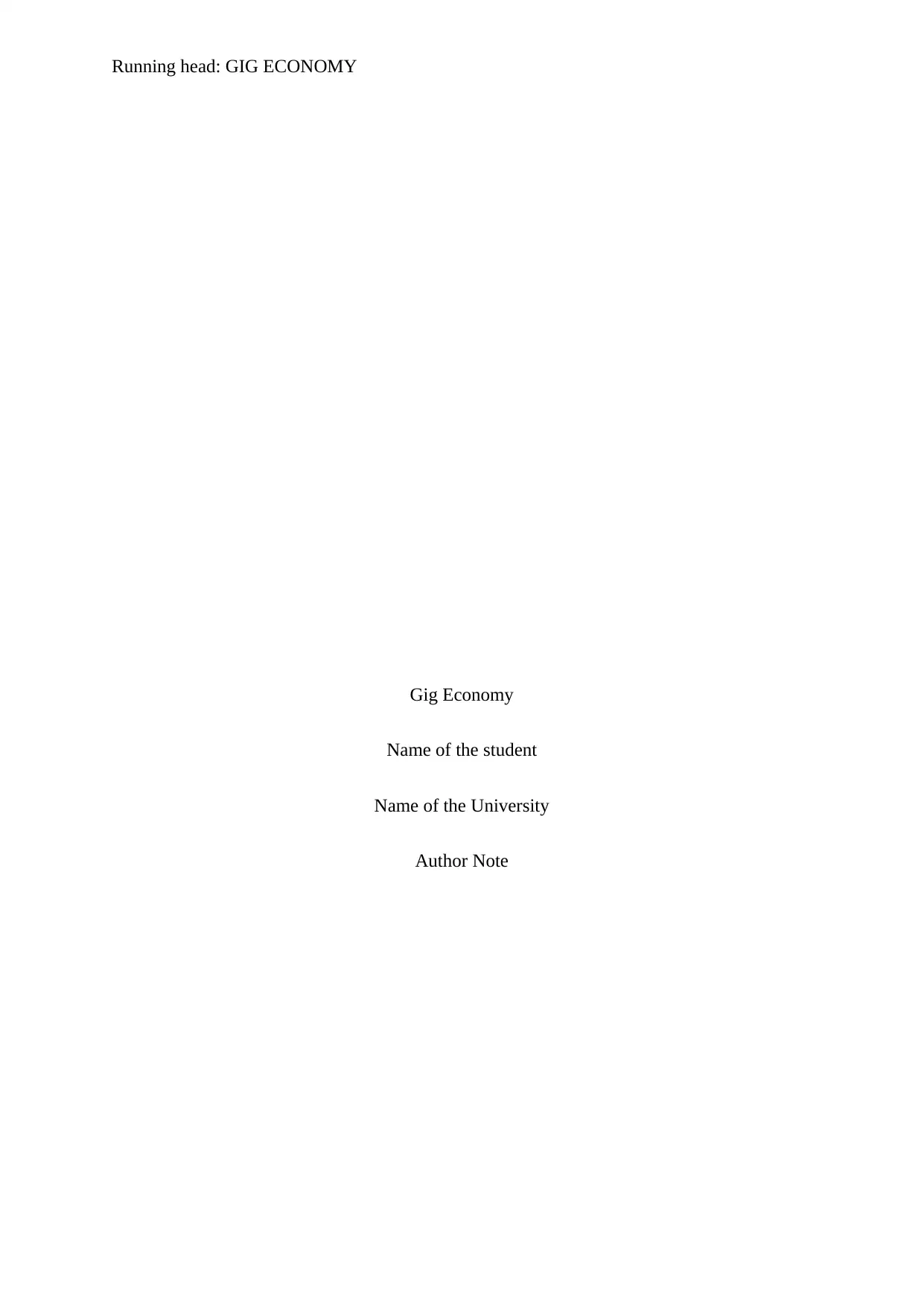
Running head: GIG ECONOMY
Gig Economy
Name of the student
Name of the University
Author Note
Gig Economy
Name of the student
Name of the University
Author Note
Paraphrase This Document
Need a fresh take? Get an instant paraphrase of this document with our AI Paraphraser
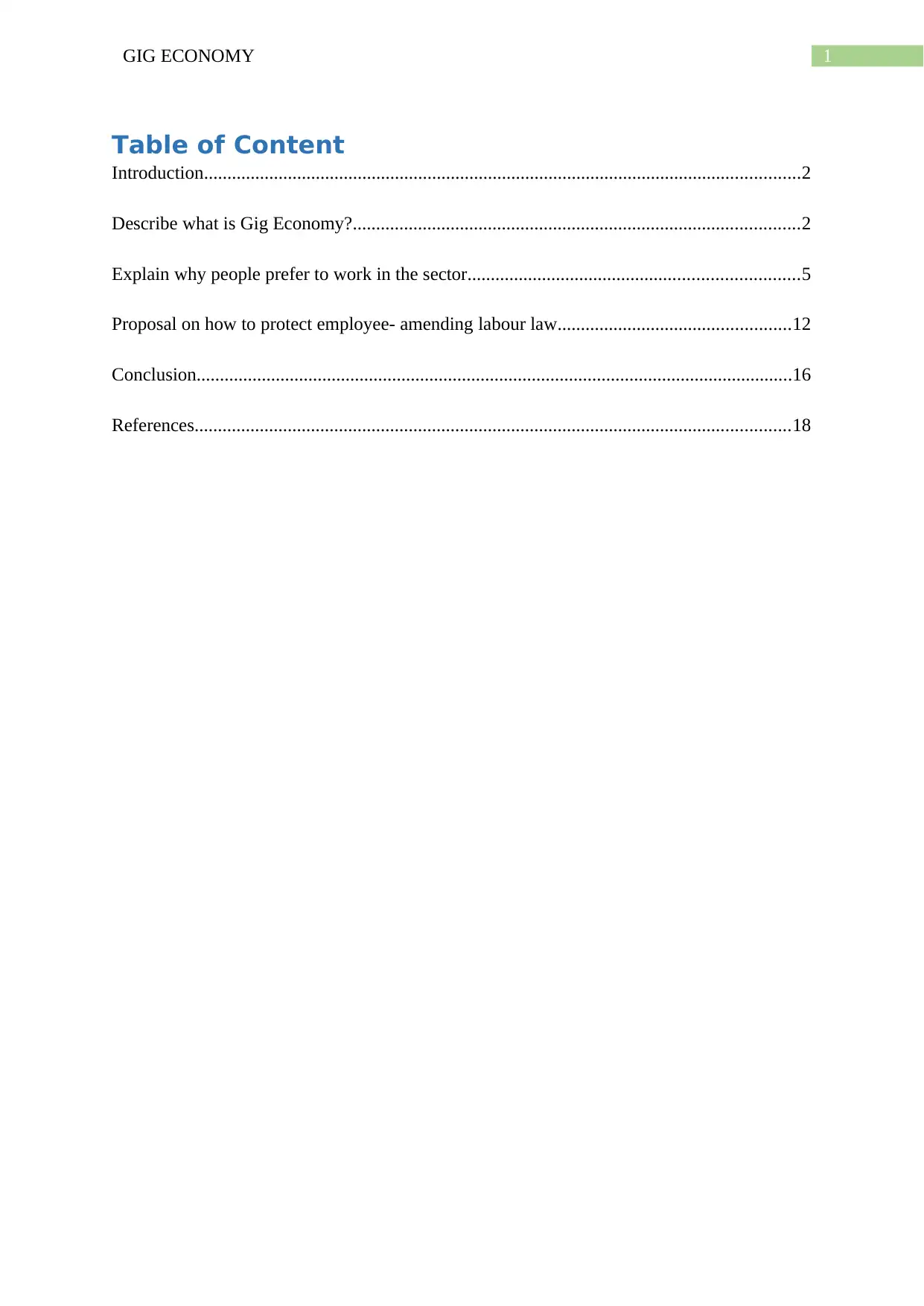
1GIG ECONOMY
Table of Content
Introduction................................................................................................................................2
Describe what is Gig Economy?................................................................................................2
Explain why people prefer to work in the sector.......................................................................5
Proposal on how to protect employee- amending labour law..................................................12
Conclusion................................................................................................................................16
References................................................................................................................................18
Table of Content
Introduction................................................................................................................................2
Describe what is Gig Economy?................................................................................................2
Explain why people prefer to work in the sector.......................................................................5
Proposal on how to protect employee- amending labour law..................................................12
Conclusion................................................................................................................................16
References................................................................................................................................18
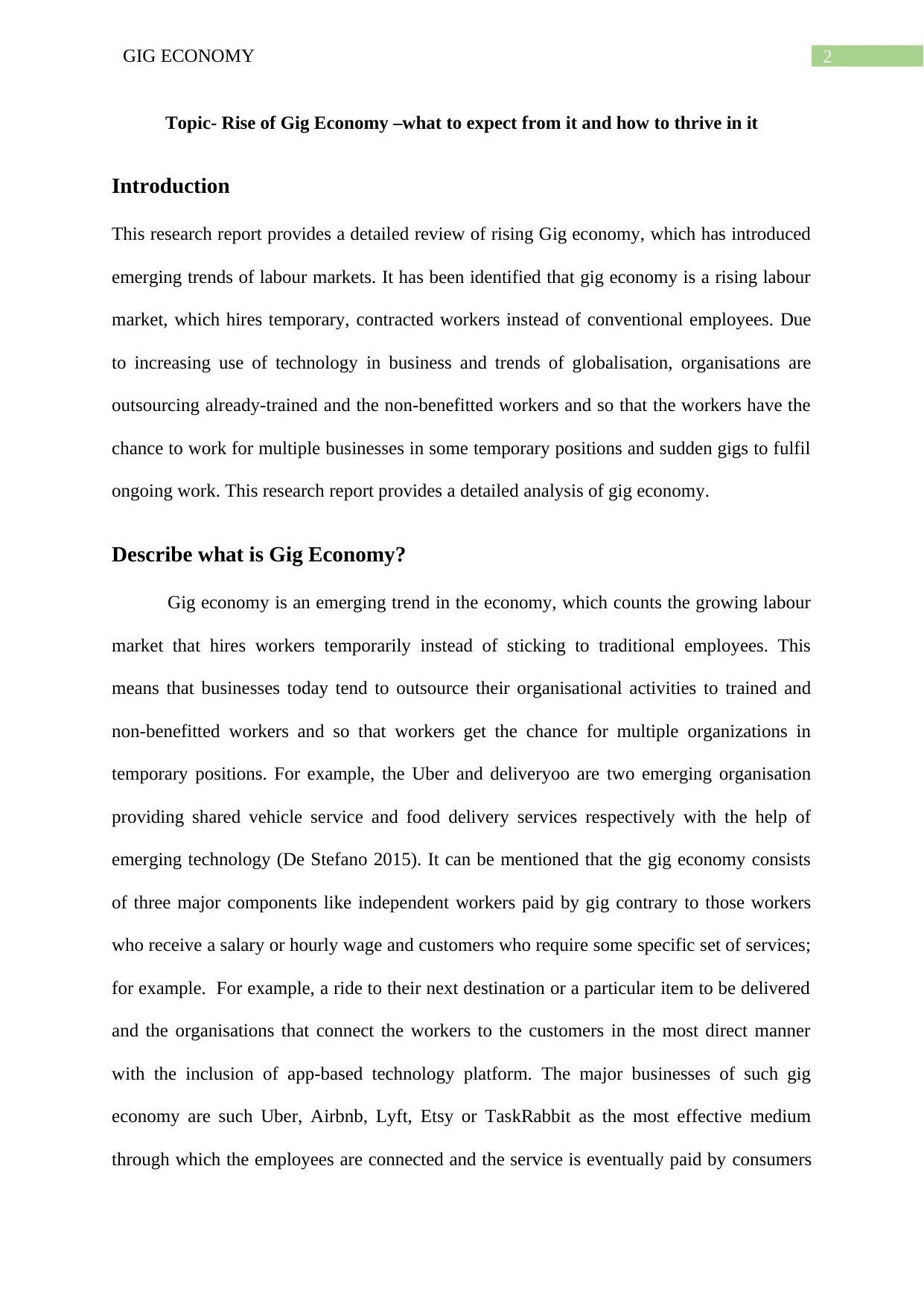
2GIG ECONOMY
Topic- Rise of Gig Economy –what to expect from it and how to thrive in it
Introduction
This research report provides a detailed review of rising Gig economy, which has introduced
emerging trends of labour markets. It has been identified that gig economy is a rising labour
market, which hires temporary, contracted workers instead of conventional employees. Due
to increasing use of technology in business and trends of globalisation, organisations are
outsourcing already-trained and the non-benefitted workers and so that the workers have the
chance to work for multiple businesses in some temporary positions and sudden gigs to fulfil
ongoing work. This research report provides a detailed analysis of gig economy.
Describe what is Gig Economy?
Gig economy is an emerging trend in the economy, which counts the growing labour
market that hires workers temporarily instead of sticking to traditional employees. This
means that businesses today tend to outsource their organisational activities to trained and
non-benefitted workers and so that workers get the chance for multiple organizations in
temporary positions. For example, the Uber and deliveryoo are two emerging organisation
providing shared vehicle service and food delivery services respectively with the help of
emerging technology (De Stefano 2015). It can be mentioned that the gig economy consists
of three major components like independent workers paid by gig contrary to those workers
who receive a salary or hourly wage and customers who require some specific set of services;
for example. For example, a ride to their next destination or a particular item to be delivered
and the organisations that connect the workers to the customers in the most direct manner
with the inclusion of app-based technology platform. The major businesses of such gig
economy are such Uber, Airbnb, Lyft, Etsy or TaskRabbit as the most effective medium
through which the employees are connected and the service is eventually paid by consumers
Topic- Rise of Gig Economy –what to expect from it and how to thrive in it
Introduction
This research report provides a detailed review of rising Gig economy, which has introduced
emerging trends of labour markets. It has been identified that gig economy is a rising labour
market, which hires temporary, contracted workers instead of conventional employees. Due
to increasing use of technology in business and trends of globalisation, organisations are
outsourcing already-trained and the non-benefitted workers and so that the workers have the
chance to work for multiple businesses in some temporary positions and sudden gigs to fulfil
ongoing work. This research report provides a detailed analysis of gig economy.
Describe what is Gig Economy?
Gig economy is an emerging trend in the economy, which counts the growing labour
market that hires workers temporarily instead of sticking to traditional employees. This
means that businesses today tend to outsource their organisational activities to trained and
non-benefitted workers and so that workers get the chance for multiple organizations in
temporary positions. For example, the Uber and deliveryoo are two emerging organisation
providing shared vehicle service and food delivery services respectively with the help of
emerging technology (De Stefano 2015). It can be mentioned that the gig economy consists
of three major components like independent workers paid by gig contrary to those workers
who receive a salary or hourly wage and customers who require some specific set of services;
for example. For example, a ride to their next destination or a particular item to be delivered
and the organisations that connect the workers to the customers in the most direct manner
with the inclusion of app-based technology platform. The major businesses of such gig
economy are such Uber, Airbnb, Lyft, Etsy or TaskRabbit as the most effective medium
through which the employees are connected and the service is eventually paid by consumers
⊘ This is a preview!⊘
Do you want full access?
Subscribe today to unlock all pages.

Trusted by 1+ million students worldwide
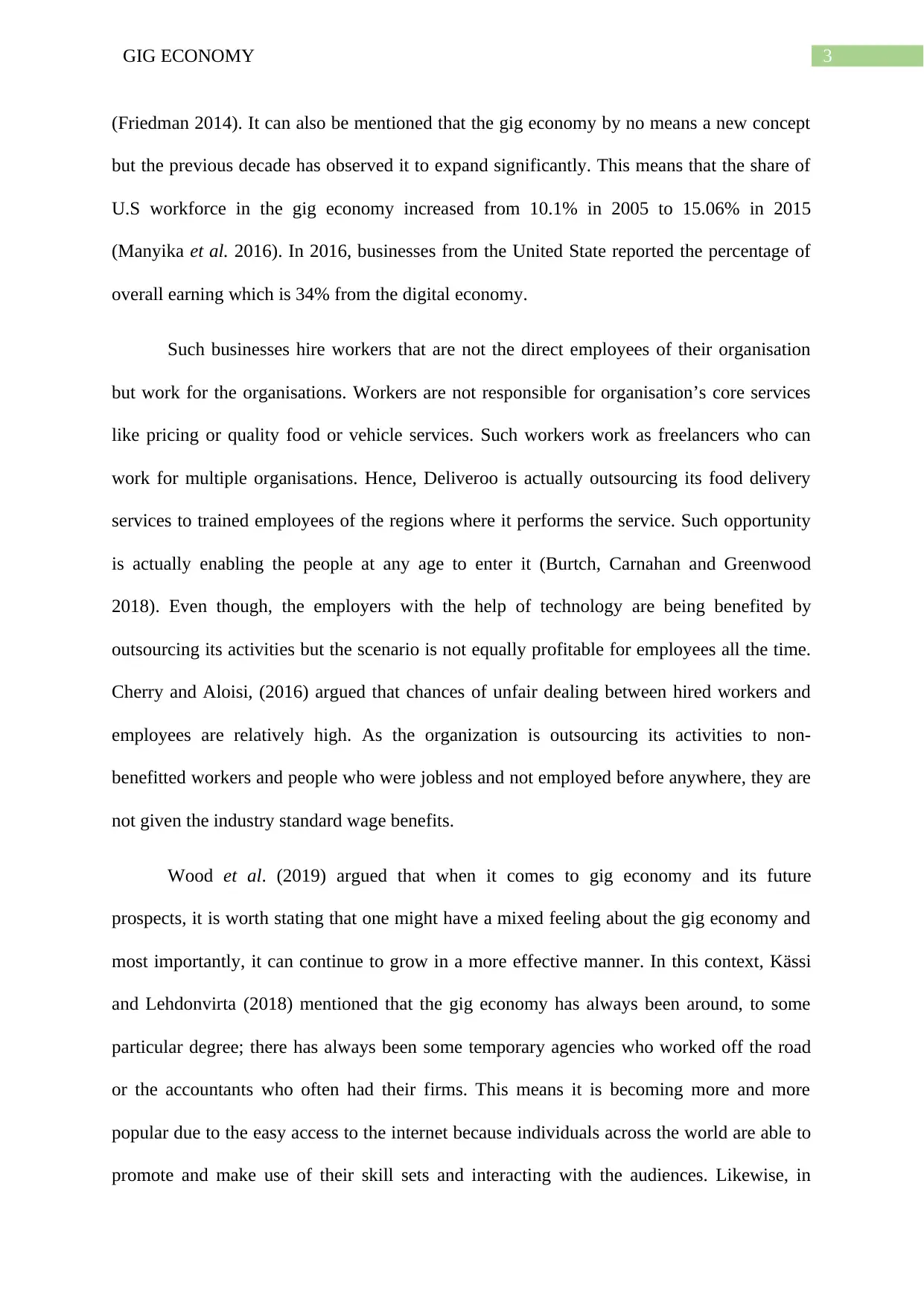
3GIG ECONOMY
(Friedman 2014). It can also be mentioned that the gig economy by no means a new concept
but the previous decade has observed it to expand significantly. This means that the share of
U.S workforce in the gig economy increased from 10.1% in 2005 to 15.06% in 2015
(Manyika et al. 2016). In 2016, businesses from the United State reported the percentage of
overall earning which is 34% from the digital economy.
Such businesses hire workers that are not the direct employees of their organisation
but work for the organisations. Workers are not responsible for organisation’s core services
like pricing or quality food or vehicle services. Such workers work as freelancers who can
work for multiple organisations. Hence, Deliveroo is actually outsourcing its food delivery
services to trained employees of the regions where it performs the service. Such opportunity
is actually enabling the people at any age to enter it (Burtch, Carnahan and Greenwood
2018). Even though, the employers with the help of technology are being benefited by
outsourcing its activities but the scenario is not equally profitable for employees all the time.
Cherry and Aloisi, (2016) argued that chances of unfair dealing between hired workers and
employees are relatively high. As the organization is outsourcing its activities to non-
benefitted workers and people who were jobless and not employed before anywhere, they are
not given the industry standard wage benefits.
Wood et al. (2019) argued that when it comes to gig economy and its future
prospects, it is worth stating that one might have a mixed feeling about the gig economy and
most importantly, it can continue to grow in a more effective manner. In this context, Kässi
and Lehdonvirta (2018) mentioned that the gig economy has always been around, to some
particular degree; there has always been some temporary agencies who worked off the road
or the accountants who often had their firms. This means it is becoming more and more
popular due to the easy access to the internet because individuals across the world are able to
promote and make use of their skill sets and interacting with the audiences. Likewise, in
(Friedman 2014). It can also be mentioned that the gig economy by no means a new concept
but the previous decade has observed it to expand significantly. This means that the share of
U.S workforce in the gig economy increased from 10.1% in 2005 to 15.06% in 2015
(Manyika et al. 2016). In 2016, businesses from the United State reported the percentage of
overall earning which is 34% from the digital economy.
Such businesses hire workers that are not the direct employees of their organisation
but work for the organisations. Workers are not responsible for organisation’s core services
like pricing or quality food or vehicle services. Such workers work as freelancers who can
work for multiple organisations. Hence, Deliveroo is actually outsourcing its food delivery
services to trained employees of the regions where it performs the service. Such opportunity
is actually enabling the people at any age to enter it (Burtch, Carnahan and Greenwood
2018). Even though, the employers with the help of technology are being benefited by
outsourcing its activities but the scenario is not equally profitable for employees all the time.
Cherry and Aloisi, (2016) argued that chances of unfair dealing between hired workers and
employees are relatively high. As the organization is outsourcing its activities to non-
benefitted workers and people who were jobless and not employed before anywhere, they are
not given the industry standard wage benefits.
Wood et al. (2019) argued that when it comes to gig economy and its future
prospects, it is worth stating that one might have a mixed feeling about the gig economy and
most importantly, it can continue to grow in a more effective manner. In this context, Kässi
and Lehdonvirta (2018) mentioned that the gig economy has always been around, to some
particular degree; there has always been some temporary agencies who worked off the road
or the accountants who often had their firms. This means it is becoming more and more
popular due to the easy access to the internet because individuals across the world are able to
promote and make use of their skill sets and interacting with the audiences. Likewise, in
Paraphrase This Document
Need a fresh take? Get an instant paraphrase of this document with our AI Paraphraser
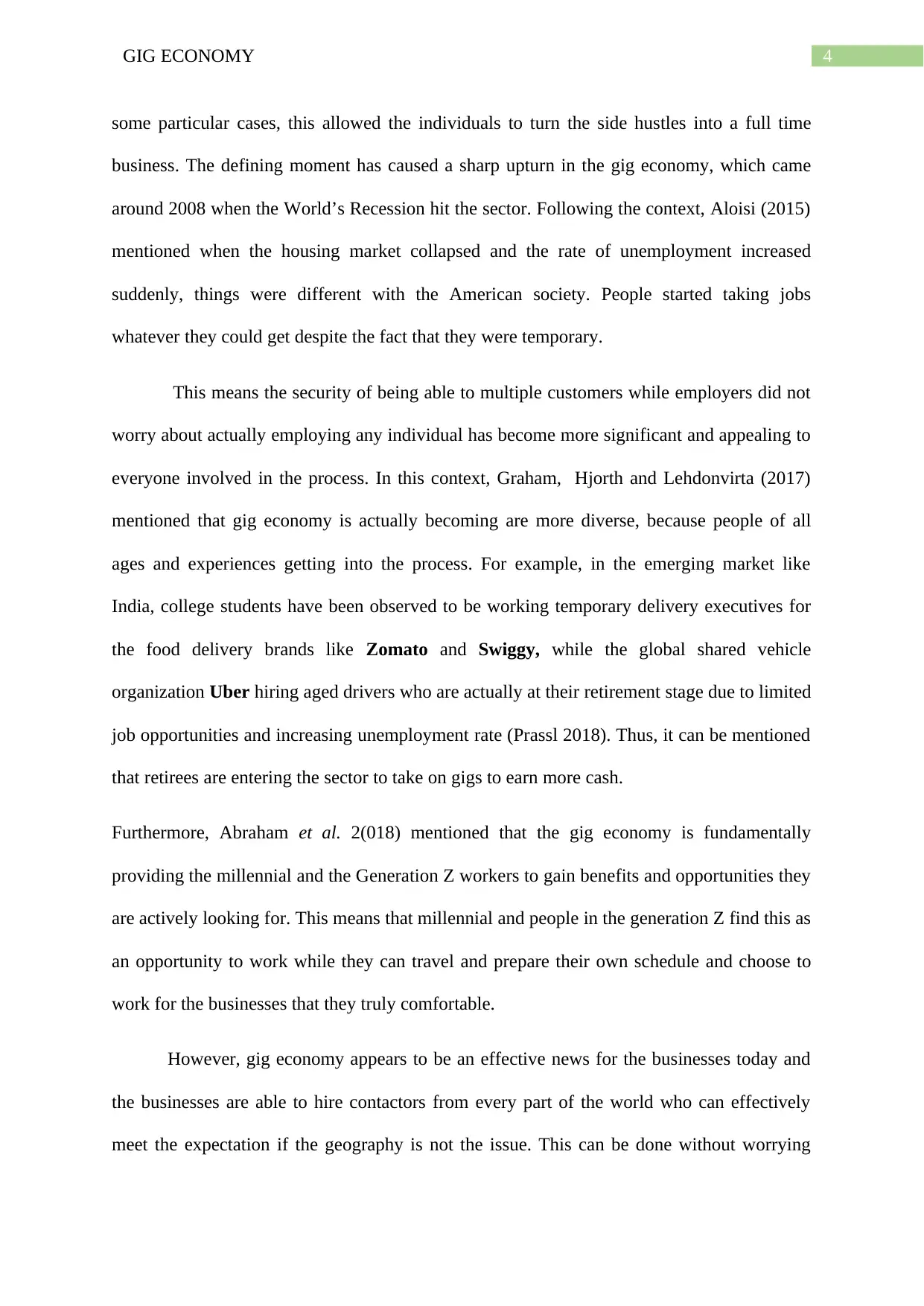
4GIG ECONOMY
some particular cases, this allowed the individuals to turn the side hustles into a full time
business. The defining moment has caused a sharp upturn in the gig economy, which came
around 2008 when the World’s Recession hit the sector. Following the context, Aloisi (2015)
mentioned when the housing market collapsed and the rate of unemployment increased
suddenly, things were different with the American society. People started taking jobs
whatever they could get despite the fact that they were temporary.
This means the security of being able to multiple customers while employers did not
worry about actually employing any individual has become more significant and appealing to
everyone involved in the process. In this context, Graham, Hjorth and Lehdonvirta (2017)
mentioned that gig economy is actually becoming are more diverse, because people of all
ages and experiences getting into the process. For example, in the emerging market like
India, college students have been observed to be working temporary delivery executives for
the food delivery brands like Zomato and Swiggy, while the global shared vehicle
organization Uber hiring aged drivers who are actually at their retirement stage due to limited
job opportunities and increasing unemployment rate (Prassl 2018). Thus, it can be mentioned
that retirees are entering the sector to take on gigs to earn more cash.
Furthermore, Abraham et al. 2(018) mentioned that the gig economy is fundamentally
providing the millennial and the Generation Z workers to gain benefits and opportunities they
are actively looking for. This means that millennial and people in the generation Z find this as
an opportunity to work while they can travel and prepare their own schedule and choose to
work for the businesses that they truly comfortable.
However, gig economy appears to be an effective news for the businesses today and
the businesses are able to hire contactors from every part of the world who can effectively
meet the expectation if the geography is not the issue. This can be done without worrying
some particular cases, this allowed the individuals to turn the side hustles into a full time
business. The defining moment has caused a sharp upturn in the gig economy, which came
around 2008 when the World’s Recession hit the sector. Following the context, Aloisi (2015)
mentioned when the housing market collapsed and the rate of unemployment increased
suddenly, things were different with the American society. People started taking jobs
whatever they could get despite the fact that they were temporary.
This means the security of being able to multiple customers while employers did not
worry about actually employing any individual has become more significant and appealing to
everyone involved in the process. In this context, Graham, Hjorth and Lehdonvirta (2017)
mentioned that gig economy is actually becoming are more diverse, because people of all
ages and experiences getting into the process. For example, in the emerging market like
India, college students have been observed to be working temporary delivery executives for
the food delivery brands like Zomato and Swiggy, while the global shared vehicle
organization Uber hiring aged drivers who are actually at their retirement stage due to limited
job opportunities and increasing unemployment rate (Prassl 2018). Thus, it can be mentioned
that retirees are entering the sector to take on gigs to earn more cash.
Furthermore, Abraham et al. 2(018) mentioned that the gig economy is fundamentally
providing the millennial and the Generation Z workers to gain benefits and opportunities they
are actively looking for. This means that millennial and people in the generation Z find this as
an opportunity to work while they can travel and prepare their own schedule and choose to
work for the businesses that they truly comfortable.
However, gig economy appears to be an effective news for the businesses today and
the businesses are able to hire contactors from every part of the world who can effectively
meet the expectation if the geography is not the issue. This can be done without worrying
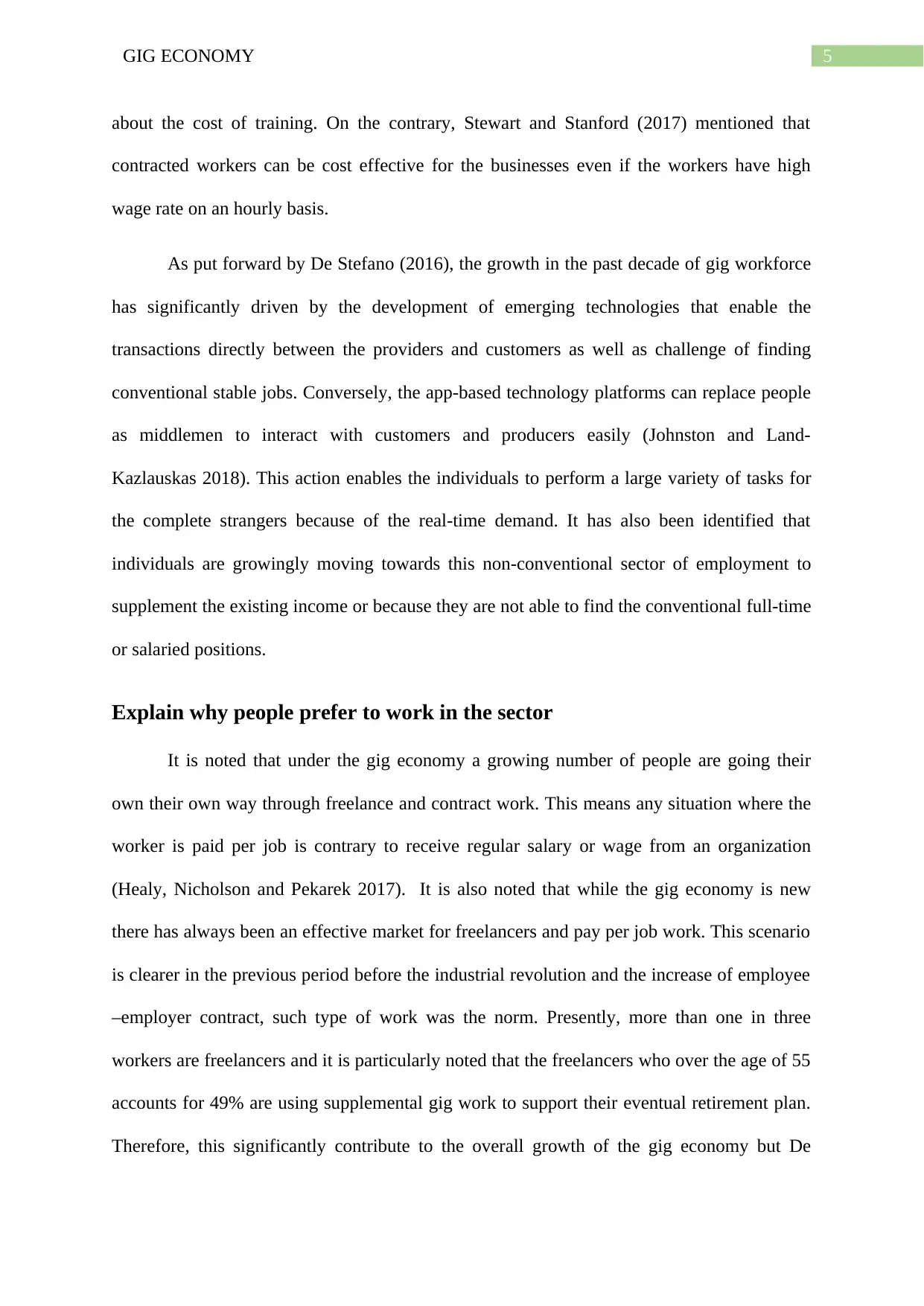
5GIG ECONOMY
about the cost of training. On the contrary, Stewart and Stanford (2017) mentioned that
contracted workers can be cost effective for the businesses even if the workers have high
wage rate on an hourly basis.
As put forward by De Stefano (2016), the growth in the past decade of gig workforce
has significantly driven by the development of emerging technologies that enable the
transactions directly between the providers and customers as well as challenge of finding
conventional stable jobs. Conversely, the app-based technology platforms can replace people
as middlemen to interact with customers and producers easily (Johnston and Land-
Kazlauskas 2018). This action enables the individuals to perform a large variety of tasks for
the complete strangers because of the real-time demand. It has also been identified that
individuals are growingly moving towards this non-conventional sector of employment to
supplement the existing income or because they are not able to find the conventional full-time
or salaried positions.
Explain why people prefer to work in the sector
It is noted that under the gig economy a growing number of people are going their
own their own way through freelance and contract work. This means any situation where the
worker is paid per job is contrary to receive regular salary or wage from an organization
(Healy, Nicholson and Pekarek 2017). It is also noted that while the gig economy is new
there has always been an effective market for freelancers and pay per job work. This scenario
is clearer in the previous period before the industrial revolution and the increase of employee
–employer contract, such type of work was the norm. Presently, more than one in three
workers are freelancers and it is particularly noted that the freelancers who over the age of 55
accounts for 49% are using supplemental gig work to support their eventual retirement plan.
Therefore, this significantly contribute to the overall growth of the gig economy but De
about the cost of training. On the contrary, Stewart and Stanford (2017) mentioned that
contracted workers can be cost effective for the businesses even if the workers have high
wage rate on an hourly basis.
As put forward by De Stefano (2016), the growth in the past decade of gig workforce
has significantly driven by the development of emerging technologies that enable the
transactions directly between the providers and customers as well as challenge of finding
conventional stable jobs. Conversely, the app-based technology platforms can replace people
as middlemen to interact with customers and producers easily (Johnston and Land-
Kazlauskas 2018). This action enables the individuals to perform a large variety of tasks for
the complete strangers because of the real-time demand. It has also been identified that
individuals are growingly moving towards this non-conventional sector of employment to
supplement the existing income or because they are not able to find the conventional full-time
or salaried positions.
Explain why people prefer to work in the sector
It is noted that under the gig economy a growing number of people are going their
own their own way through freelance and contract work. This means any situation where the
worker is paid per job is contrary to receive regular salary or wage from an organization
(Healy, Nicholson and Pekarek 2017). It is also noted that while the gig economy is new
there has always been an effective market for freelancers and pay per job work. This scenario
is clearer in the previous period before the industrial revolution and the increase of employee
–employer contract, such type of work was the norm. Presently, more than one in three
workers are freelancers and it is particularly noted that the freelancers who over the age of 55
accounts for 49% are using supplemental gig work to support their eventual retirement plan.
Therefore, this significantly contribute to the overall growth of the gig economy but De
⊘ This is a preview!⊘
Do you want full access?
Subscribe today to unlock all pages.

Trusted by 1+ million students worldwide
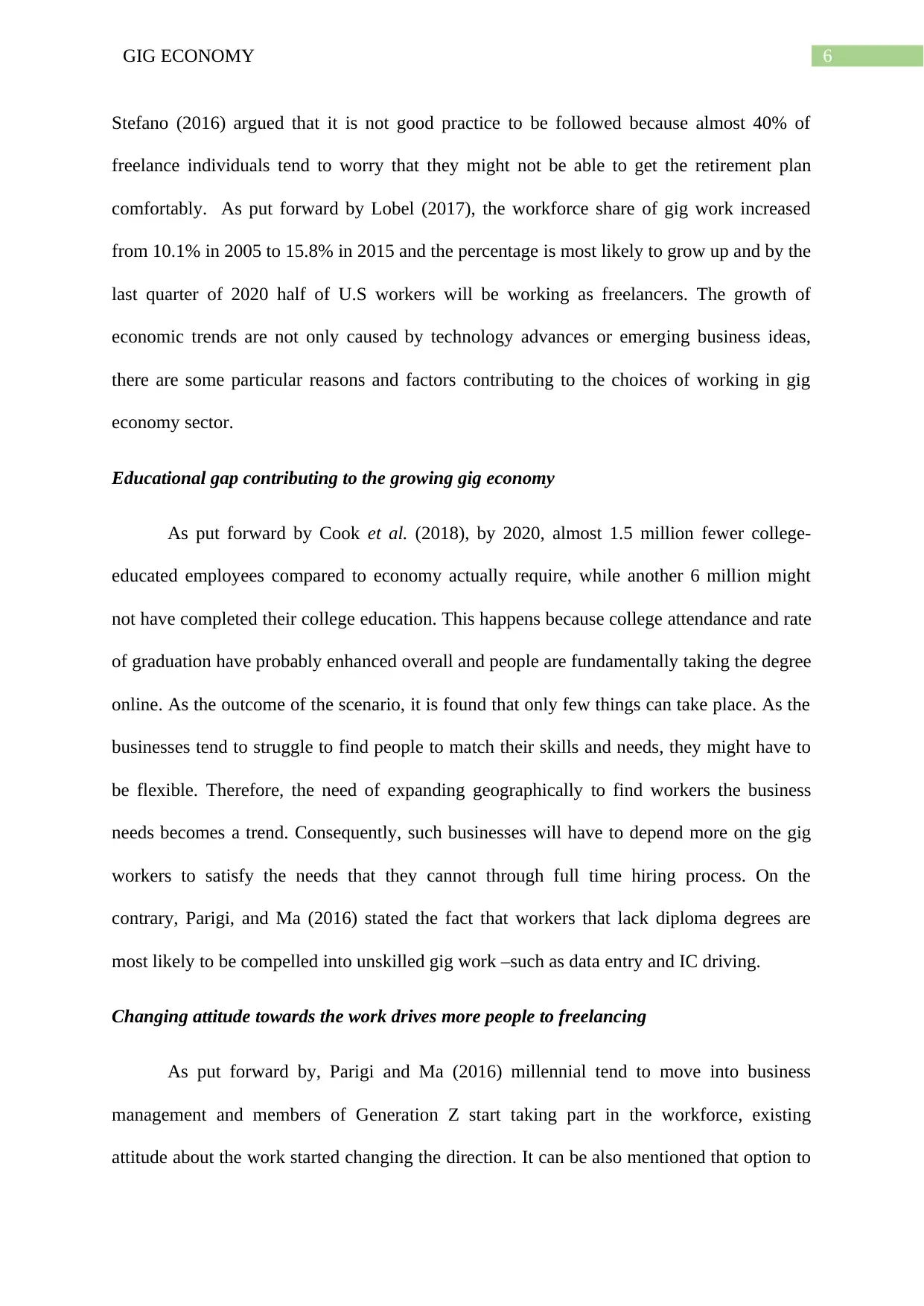
6GIG ECONOMY
Stefano (2016) argued that it is not good practice to be followed because almost 40% of
freelance individuals tend to worry that they might not be able to get the retirement plan
comfortably. As put forward by Lobel (2017), the workforce share of gig work increased
from 10.1% in 2005 to 15.8% in 2015 and the percentage is most likely to grow up and by the
last quarter of 2020 half of U.S workers will be working as freelancers. The growth of
economic trends are not only caused by technology advances or emerging business ideas,
there are some particular reasons and factors contributing to the choices of working in gig
economy sector.
Educational gap contributing to the growing gig economy
As put forward by Cook et al. (2018), by 2020, almost 1.5 million fewer college-
educated employees compared to economy actually require, while another 6 million might
not have completed their college education. This happens because college attendance and rate
of graduation have probably enhanced overall and people are fundamentally taking the degree
online. As the outcome of the scenario, it is found that only few things can take place. As the
businesses tend to struggle to find people to match their skills and needs, they might have to
be flexible. Therefore, the need of expanding geographically to find workers the business
needs becomes a trend. Consequently, such businesses will have to depend more on the gig
workers to satisfy the needs that they cannot through full time hiring process. On the
contrary, Parigi, and Ma (2016) stated the fact that workers that lack diploma degrees are
most likely to be compelled into unskilled gig work –such as data entry and IC driving.
Changing attitude towards the work drives more people to freelancing
As put forward by, Parigi and Ma (2016) millennial tend to move into business
management and members of Generation Z start taking part in the workforce, existing
attitude about the work started changing the direction. It can be also mentioned that option to
Stefano (2016) argued that it is not good practice to be followed because almost 40% of
freelance individuals tend to worry that they might not be able to get the retirement plan
comfortably. As put forward by Lobel (2017), the workforce share of gig work increased
from 10.1% in 2005 to 15.8% in 2015 and the percentage is most likely to grow up and by the
last quarter of 2020 half of U.S workers will be working as freelancers. The growth of
economic trends are not only caused by technology advances or emerging business ideas,
there are some particular reasons and factors contributing to the choices of working in gig
economy sector.
Educational gap contributing to the growing gig economy
As put forward by Cook et al. (2018), by 2020, almost 1.5 million fewer college-
educated employees compared to economy actually require, while another 6 million might
not have completed their college education. This happens because college attendance and rate
of graduation have probably enhanced overall and people are fundamentally taking the degree
online. As the outcome of the scenario, it is found that only few things can take place. As the
businesses tend to struggle to find people to match their skills and needs, they might have to
be flexible. Therefore, the need of expanding geographically to find workers the business
needs becomes a trend. Consequently, such businesses will have to depend more on the gig
workers to satisfy the needs that they cannot through full time hiring process. On the
contrary, Parigi, and Ma (2016) stated the fact that workers that lack diploma degrees are
most likely to be compelled into unskilled gig work –such as data entry and IC driving.
Changing attitude towards the work drives more people to freelancing
As put forward by, Parigi and Ma (2016) millennial tend to move into business
management and members of Generation Z start taking part in the workforce, existing
attitude about the work started changing the direction. It can be also mentioned that option to
Paraphrase This Document
Need a fresh take? Get an instant paraphrase of this document with our AI Paraphraser
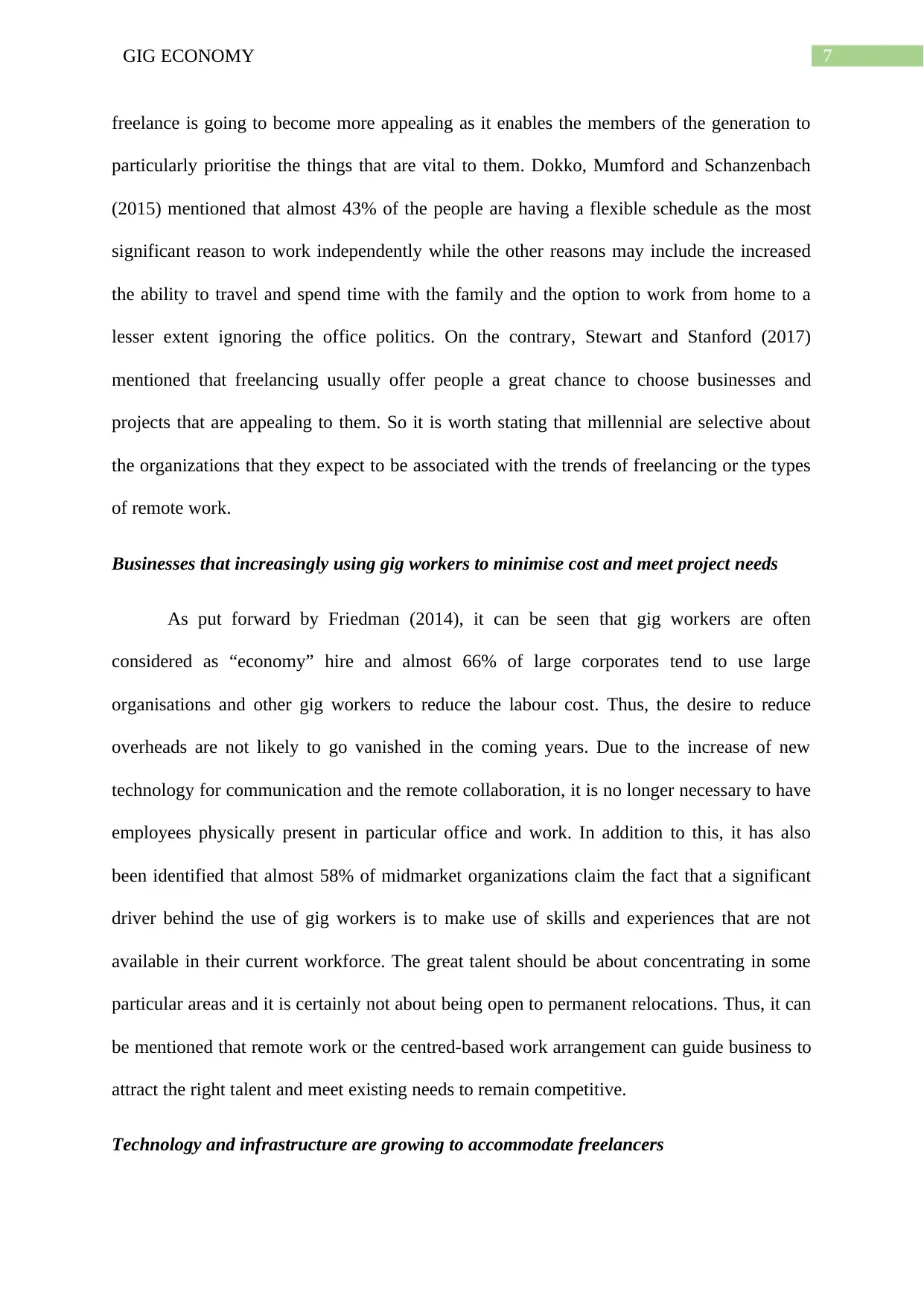
7GIG ECONOMY
freelance is going to become more appealing as it enables the members of the generation to
particularly prioritise the things that are vital to them. Dokko, Mumford and Schanzenbach
(2015) mentioned that almost 43% of the people are having a flexible schedule as the most
significant reason to work independently while the other reasons may include the increased
the ability to travel and spend time with the family and the option to work from home to a
lesser extent ignoring the office politics. On the contrary, Stewart and Stanford (2017)
mentioned that freelancing usually offer people a great chance to choose businesses and
projects that are appealing to them. So it is worth stating that millennial are selective about
the organizations that they expect to be associated with the trends of freelancing or the types
of remote work.
Businesses that increasingly using gig workers to minimise cost and meet project needs
As put forward by Friedman (2014), it can be seen that gig workers are often
considered as “economy” hire and almost 66% of large corporates tend to use large
organisations and other gig workers to reduce the labour cost. Thus, the desire to reduce
overheads are not likely to go vanished in the coming years. Due to the increase of new
technology for communication and the remote collaboration, it is no longer necessary to have
employees physically present in particular office and work. In addition to this, it has also
been identified that almost 58% of midmarket organizations claim the fact that a significant
driver behind the use of gig workers is to make use of skills and experiences that are not
available in their current workforce. The great talent should be about concentrating in some
particular areas and it is certainly not about being open to permanent relocations. Thus, it can
be mentioned that remote work or the centred-based work arrangement can guide business to
attract the right talent and meet existing needs to remain competitive.
Technology and infrastructure are growing to accommodate freelancers
freelance is going to become more appealing as it enables the members of the generation to
particularly prioritise the things that are vital to them. Dokko, Mumford and Schanzenbach
(2015) mentioned that almost 43% of the people are having a flexible schedule as the most
significant reason to work independently while the other reasons may include the increased
the ability to travel and spend time with the family and the option to work from home to a
lesser extent ignoring the office politics. On the contrary, Stewart and Stanford (2017)
mentioned that freelancing usually offer people a great chance to choose businesses and
projects that are appealing to them. So it is worth stating that millennial are selective about
the organizations that they expect to be associated with the trends of freelancing or the types
of remote work.
Businesses that increasingly using gig workers to minimise cost and meet project needs
As put forward by Friedman (2014), it can be seen that gig workers are often
considered as “economy” hire and almost 66% of large corporates tend to use large
organisations and other gig workers to reduce the labour cost. Thus, the desire to reduce
overheads are not likely to go vanished in the coming years. Due to the increase of new
technology for communication and the remote collaboration, it is no longer necessary to have
employees physically present in particular office and work. In addition to this, it has also
been identified that almost 58% of midmarket organizations claim the fact that a significant
driver behind the use of gig workers is to make use of skills and experiences that are not
available in their current workforce. The great talent should be about concentrating in some
particular areas and it is certainly not about being open to permanent relocations. Thus, it can
be mentioned that remote work or the centred-based work arrangement can guide business to
attract the right talent and meet existing needs to remain competitive.
Technology and infrastructure are growing to accommodate freelancers
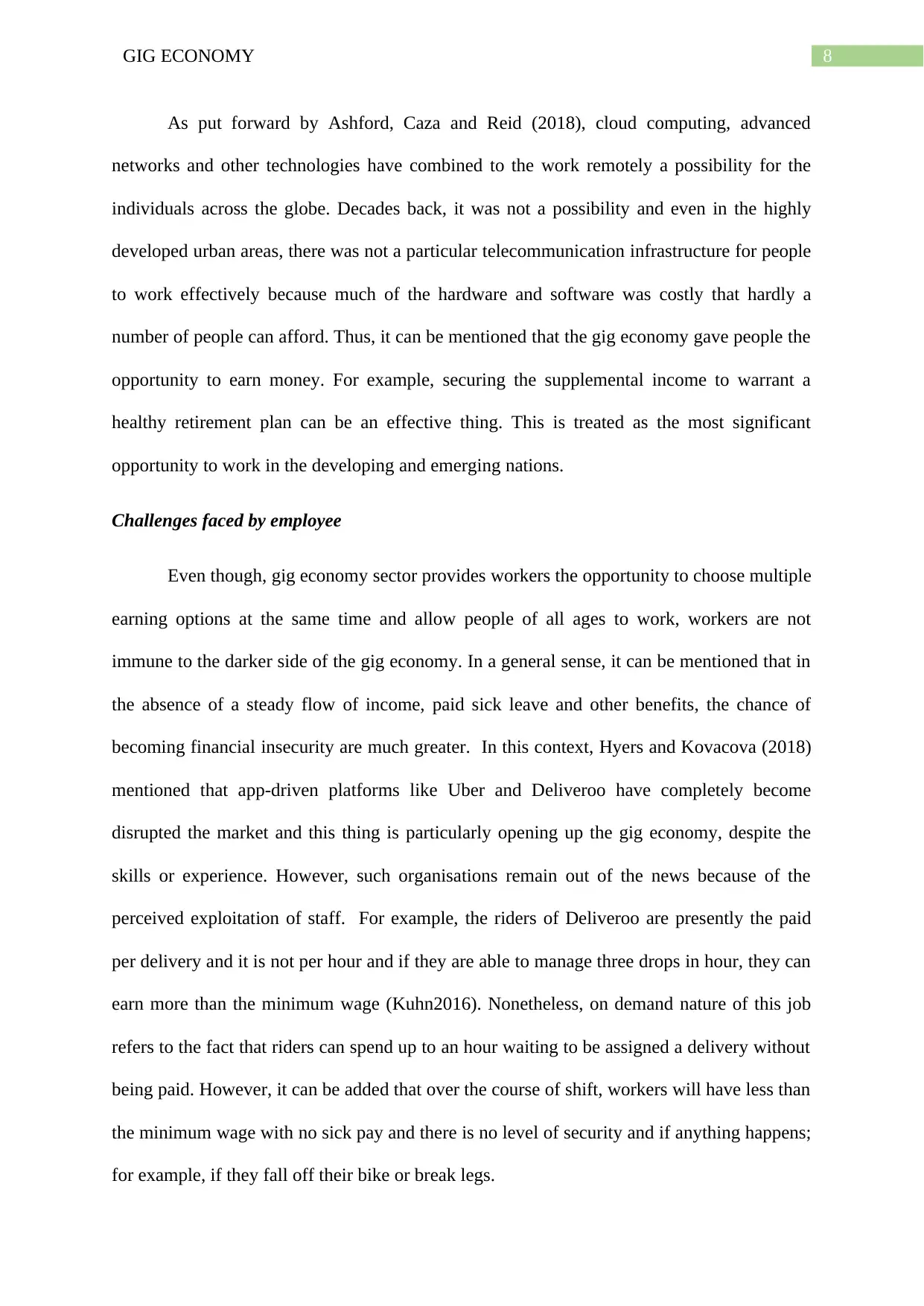
8GIG ECONOMY
As put forward by Ashford, Caza and Reid (2018), cloud computing, advanced
networks and other technologies have combined to the work remotely a possibility for the
individuals across the globe. Decades back, it was not a possibility and even in the highly
developed urban areas, there was not a particular telecommunication infrastructure for people
to work effectively because much of the hardware and software was costly that hardly a
number of people can afford. Thus, it can be mentioned that the gig economy gave people the
opportunity to earn money. For example, securing the supplemental income to warrant a
healthy retirement plan can be an effective thing. This is treated as the most significant
opportunity to work in the developing and emerging nations.
Challenges faced by employee
Even though, gig economy sector provides workers the opportunity to choose multiple
earning options at the same time and allow people of all ages to work, workers are not
immune to the darker side of the gig economy. In a general sense, it can be mentioned that in
the absence of a steady flow of income, paid sick leave and other benefits, the chance of
becoming financial insecurity are much greater. In this context, Hyers and Kovacova (2018)
mentioned that app-driven platforms like Uber and Deliveroo have completely become
disrupted the market and this thing is particularly opening up the gig economy, despite the
skills or experience. However, such organisations remain out of the news because of the
perceived exploitation of staff. For example, the riders of Deliveroo are presently the paid
per delivery and it is not per hour and if they are able to manage three drops in hour, they can
earn more than the minimum wage (Kuhn2016). Nonetheless, on demand nature of this job
refers to the fact that riders can spend up to an hour waiting to be assigned a delivery without
being paid. However, it can be added that over the course of shift, workers will have less than
the minimum wage with no sick pay and there is no level of security and if anything happens;
for example, if they fall off their bike or break legs.
As put forward by Ashford, Caza and Reid (2018), cloud computing, advanced
networks and other technologies have combined to the work remotely a possibility for the
individuals across the globe. Decades back, it was not a possibility and even in the highly
developed urban areas, there was not a particular telecommunication infrastructure for people
to work effectively because much of the hardware and software was costly that hardly a
number of people can afford. Thus, it can be mentioned that the gig economy gave people the
opportunity to earn money. For example, securing the supplemental income to warrant a
healthy retirement plan can be an effective thing. This is treated as the most significant
opportunity to work in the developing and emerging nations.
Challenges faced by employee
Even though, gig economy sector provides workers the opportunity to choose multiple
earning options at the same time and allow people of all ages to work, workers are not
immune to the darker side of the gig economy. In a general sense, it can be mentioned that in
the absence of a steady flow of income, paid sick leave and other benefits, the chance of
becoming financial insecurity are much greater. In this context, Hyers and Kovacova (2018)
mentioned that app-driven platforms like Uber and Deliveroo have completely become
disrupted the market and this thing is particularly opening up the gig economy, despite the
skills or experience. However, such organisations remain out of the news because of the
perceived exploitation of staff. For example, the riders of Deliveroo are presently the paid
per delivery and it is not per hour and if they are able to manage three drops in hour, they can
earn more than the minimum wage (Kuhn2016). Nonetheless, on demand nature of this job
refers to the fact that riders can spend up to an hour waiting to be assigned a delivery without
being paid. However, it can be added that over the course of shift, workers will have less than
the minimum wage with no sick pay and there is no level of security and if anything happens;
for example, if they fall off their bike or break legs.
⊘ This is a preview!⊘
Do you want full access?
Subscribe today to unlock all pages.

Trusted by 1+ million students worldwide
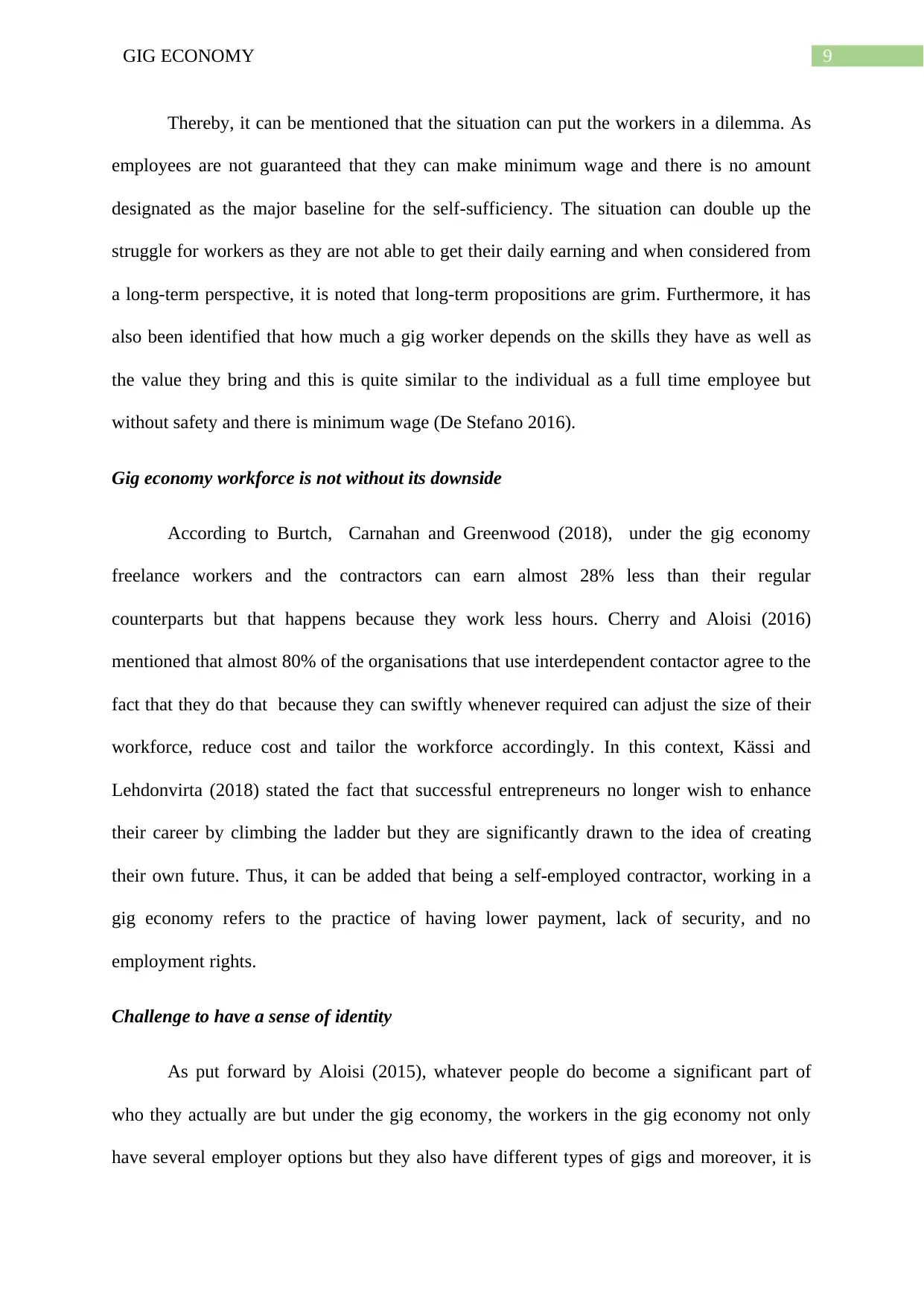
9GIG ECONOMY
Thereby, it can be mentioned that the situation can put the workers in a dilemma. As
employees are not guaranteed that they can make minimum wage and there is no amount
designated as the major baseline for the self-sufficiency. The situation can double up the
struggle for workers as they are not able to get their daily earning and when considered from
a long-term perspective, it is noted that long-term propositions are grim. Furthermore, it has
also been identified that how much a gig worker depends on the skills they have as well as
the value they bring and this is quite similar to the individual as a full time employee but
without safety and there is minimum wage (De Stefano 2016).
Gig economy workforce is not without its downside
According to Burtch, Carnahan and Greenwood (2018), under the gig economy
freelance workers and the contractors can earn almost 28% less than their regular
counterparts but that happens because they work less hours. Cherry and Aloisi (2016)
mentioned that almost 80% of the organisations that use interdependent contactor agree to the
fact that they do that because they can swiftly whenever required can adjust the size of their
workforce, reduce cost and tailor the workforce accordingly. In this context, Kässi and
Lehdonvirta (2018) stated the fact that successful entrepreneurs no longer wish to enhance
their career by climbing the ladder but they are significantly drawn to the idea of creating
their own future. Thus, it can be added that being a self-employed contractor, working in a
gig economy refers to the practice of having lower payment, lack of security, and no
employment rights.
Challenge to have a sense of identity
As put forward by Aloisi (2015), whatever people do become a significant part of
who they actually are but under the gig economy, the workers in the gig economy not only
have several employer options but they also have different types of gigs and moreover, it is
Thereby, it can be mentioned that the situation can put the workers in a dilemma. As
employees are not guaranteed that they can make minimum wage and there is no amount
designated as the major baseline for the self-sufficiency. The situation can double up the
struggle for workers as they are not able to get their daily earning and when considered from
a long-term perspective, it is noted that long-term propositions are grim. Furthermore, it has
also been identified that how much a gig worker depends on the skills they have as well as
the value they bring and this is quite similar to the individual as a full time employee but
without safety and there is minimum wage (De Stefano 2016).
Gig economy workforce is not without its downside
According to Burtch, Carnahan and Greenwood (2018), under the gig economy
freelance workers and the contractors can earn almost 28% less than their regular
counterparts but that happens because they work less hours. Cherry and Aloisi (2016)
mentioned that almost 80% of the organisations that use interdependent contactor agree to the
fact that they do that because they can swiftly whenever required can adjust the size of their
workforce, reduce cost and tailor the workforce accordingly. In this context, Kässi and
Lehdonvirta (2018) stated the fact that successful entrepreneurs no longer wish to enhance
their career by climbing the ladder but they are significantly drawn to the idea of creating
their own future. Thus, it can be added that being a self-employed contractor, working in a
gig economy refers to the practice of having lower payment, lack of security, and no
employment rights.
Challenge to have a sense of identity
As put forward by Aloisi (2015), whatever people do become a significant part of
who they actually are but under the gig economy, the workers in the gig economy not only
have several employer options but they also have different types of gigs and moreover, it is
Paraphrase This Document
Need a fresh take? Get an instant paraphrase of this document with our AI Paraphraser
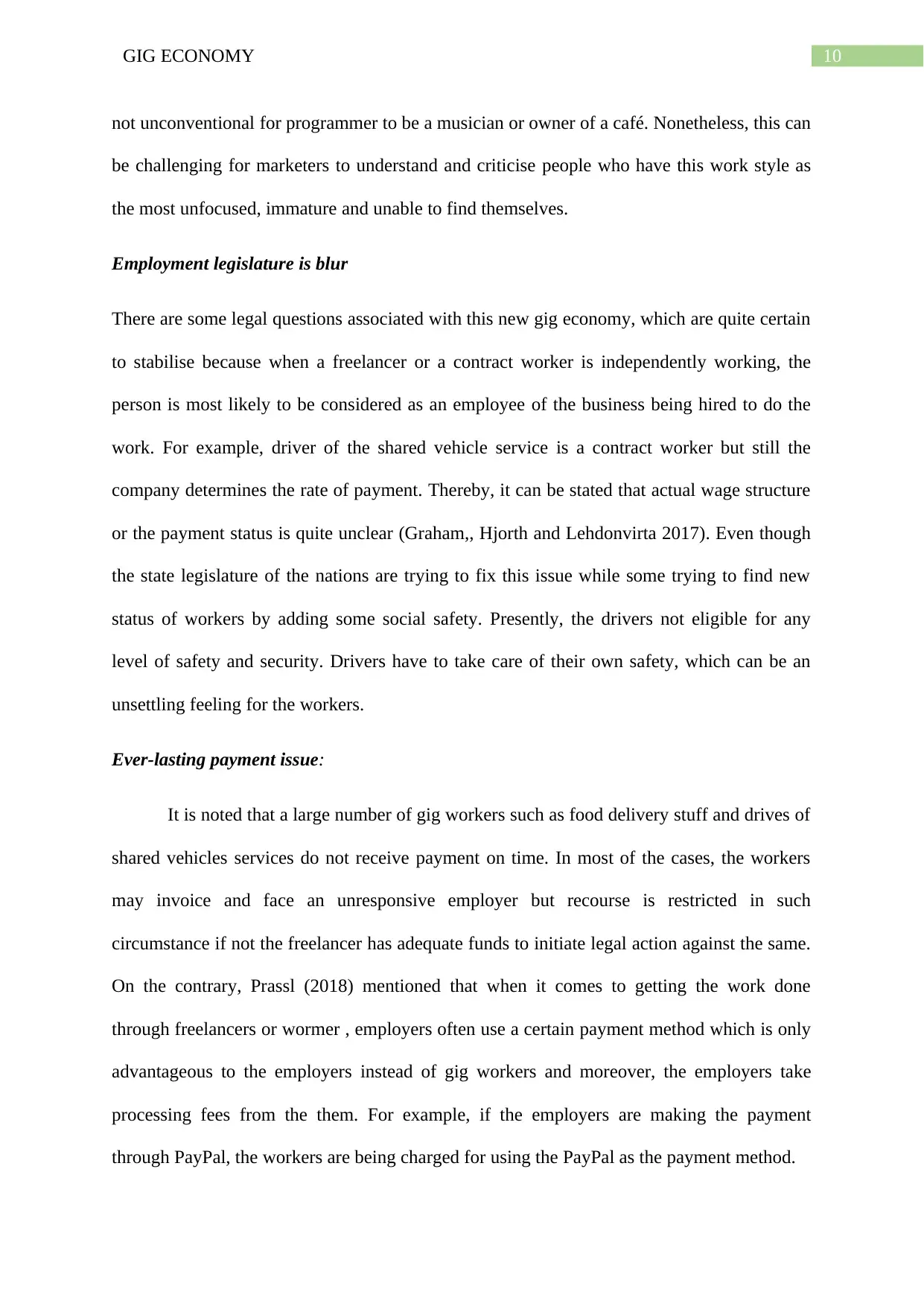
10GIG ECONOMY
not unconventional for programmer to be a musician or owner of a café. Nonetheless, this can
be challenging for marketers to understand and criticise people who have this work style as
the most unfocused, immature and unable to find themselves.
Employment legislature is blur
There are some legal questions associated with this new gig economy, which are quite certain
to stabilise because when a freelancer or a contract worker is independently working, the
person is most likely to be considered as an employee of the business being hired to do the
work. For example, driver of the shared vehicle service is a contract worker but still the
company determines the rate of payment. Thereby, it can be stated that actual wage structure
or the payment status is quite unclear (Graham,, Hjorth and Lehdonvirta 2017). Even though
the state legislature of the nations are trying to fix this issue while some trying to find new
status of workers by adding some social safety. Presently, the drivers not eligible for any
level of safety and security. Drivers have to take care of their own safety, which can be an
unsettling feeling for the workers.
Ever-lasting payment issue:
It is noted that a large number of gig workers such as food delivery stuff and drives of
shared vehicles services do not receive payment on time. In most of the cases, the workers
may invoice and face an unresponsive employer but recourse is restricted in such
circumstance if not the freelancer has adequate funds to initiate legal action against the same.
On the contrary, Prassl (2018) mentioned that when it comes to getting the work done
through freelancers or wormer , employers often use a certain payment method which is only
advantageous to the employers instead of gig workers and moreover, the employers take
processing fees from the them. For example, if the employers are making the payment
through PayPal, the workers are being charged for using the PayPal as the payment method.
not unconventional for programmer to be a musician or owner of a café. Nonetheless, this can
be challenging for marketers to understand and criticise people who have this work style as
the most unfocused, immature and unable to find themselves.
Employment legislature is blur
There are some legal questions associated with this new gig economy, which are quite certain
to stabilise because when a freelancer or a contract worker is independently working, the
person is most likely to be considered as an employee of the business being hired to do the
work. For example, driver of the shared vehicle service is a contract worker but still the
company determines the rate of payment. Thereby, it can be stated that actual wage structure
or the payment status is quite unclear (Graham,, Hjorth and Lehdonvirta 2017). Even though
the state legislature of the nations are trying to fix this issue while some trying to find new
status of workers by adding some social safety. Presently, the drivers not eligible for any
level of safety and security. Drivers have to take care of their own safety, which can be an
unsettling feeling for the workers.
Ever-lasting payment issue:
It is noted that a large number of gig workers such as food delivery stuff and drives of
shared vehicles services do not receive payment on time. In most of the cases, the workers
may invoice and face an unresponsive employer but recourse is restricted in such
circumstance if not the freelancer has adequate funds to initiate legal action against the same.
On the contrary, Prassl (2018) mentioned that when it comes to getting the work done
through freelancers or wormer , employers often use a certain payment method which is only
advantageous to the employers instead of gig workers and moreover, the employers take
processing fees from the them. For example, if the employers are making the payment
through PayPal, the workers are being charged for using the PayPal as the payment method.
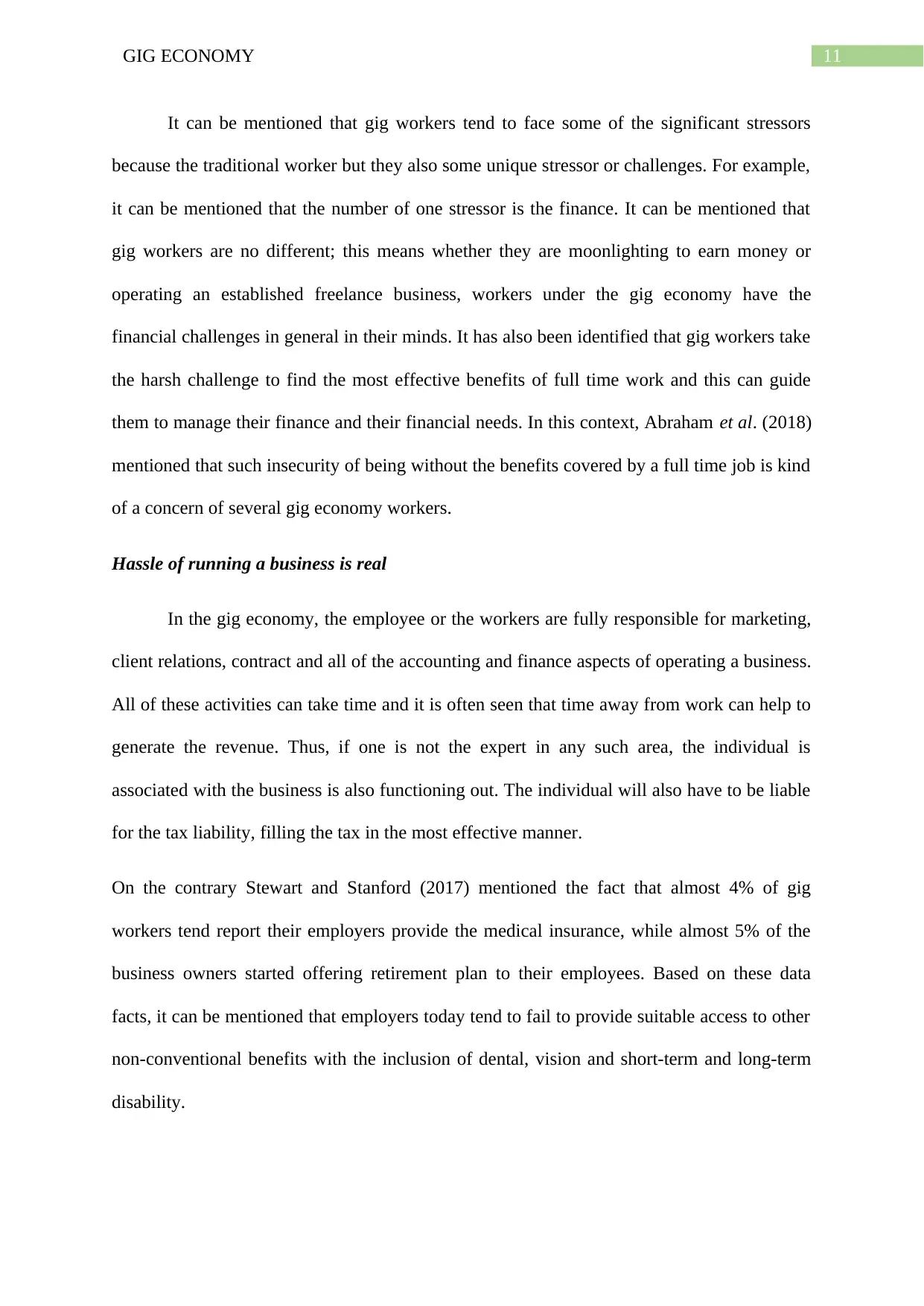
11GIG ECONOMY
It can be mentioned that gig workers tend to face some of the significant stressors
because the traditional worker but they also some unique stressor or challenges. For example,
it can be mentioned that the number of one stressor is the finance. It can be mentioned that
gig workers are no different; this means whether they are moonlighting to earn money or
operating an established freelance business, workers under the gig economy have the
financial challenges in general in their minds. It has also been identified that gig workers take
the harsh challenge to find the most effective benefits of full time work and this can guide
them to manage their finance and their financial needs. In this context, Abraham et al. (2018)
mentioned that such insecurity of being without the benefits covered by a full time job is kind
of a concern of several gig economy workers.
Hassle of running a business is real
In the gig economy, the employee or the workers are fully responsible for marketing,
client relations, contract and all of the accounting and finance aspects of operating a business.
All of these activities can take time and it is often seen that time away from work can help to
generate the revenue. Thus, if one is not the expert in any such area, the individual is
associated with the business is also functioning out. The individual will also have to be liable
for the tax liability, filling the tax in the most effective manner.
On the contrary Stewart and Stanford (2017) mentioned the fact that almost 4% of gig
workers tend report their employers provide the medical insurance, while almost 5% of the
business owners started offering retirement plan to their employees. Based on these data
facts, it can be mentioned that employers today tend to fail to provide suitable access to other
non-conventional benefits with the inclusion of dental, vision and short-term and long-term
disability.
It can be mentioned that gig workers tend to face some of the significant stressors
because the traditional worker but they also some unique stressor or challenges. For example,
it can be mentioned that the number of one stressor is the finance. It can be mentioned that
gig workers are no different; this means whether they are moonlighting to earn money or
operating an established freelance business, workers under the gig economy have the
financial challenges in general in their minds. It has also been identified that gig workers take
the harsh challenge to find the most effective benefits of full time work and this can guide
them to manage their finance and their financial needs. In this context, Abraham et al. (2018)
mentioned that such insecurity of being without the benefits covered by a full time job is kind
of a concern of several gig economy workers.
Hassle of running a business is real
In the gig economy, the employee or the workers are fully responsible for marketing,
client relations, contract and all of the accounting and finance aspects of operating a business.
All of these activities can take time and it is often seen that time away from work can help to
generate the revenue. Thus, if one is not the expert in any such area, the individual is
associated with the business is also functioning out. The individual will also have to be liable
for the tax liability, filling the tax in the most effective manner.
On the contrary Stewart and Stanford (2017) mentioned the fact that almost 4% of gig
workers tend report their employers provide the medical insurance, while almost 5% of the
business owners started offering retirement plan to their employees. Based on these data
facts, it can be mentioned that employers today tend to fail to provide suitable access to other
non-conventional benefits with the inclusion of dental, vision and short-term and long-term
disability.
⊘ This is a preview!⊘
Do you want full access?
Subscribe today to unlock all pages.

Trusted by 1+ million students worldwide
1 out of 22
Related Documents
Your All-in-One AI-Powered Toolkit for Academic Success.
+13062052269
info@desklib.com
Available 24*7 on WhatsApp / Email
![[object Object]](/_next/static/media/star-bottom.7253800d.svg)
Unlock your academic potential
Copyright © 2020–2025 A2Z Services. All Rights Reserved. Developed and managed by ZUCOL.





